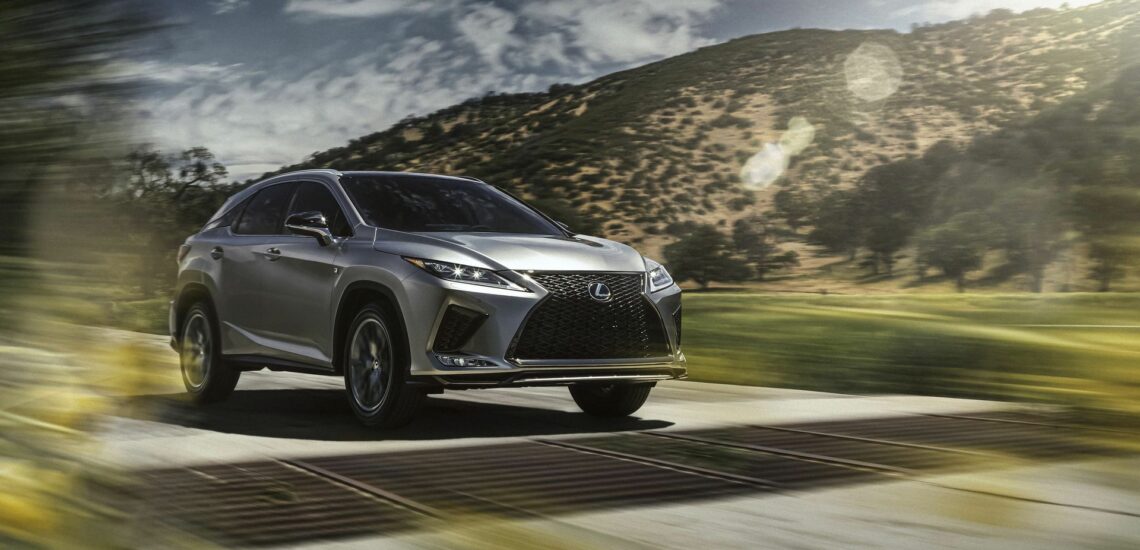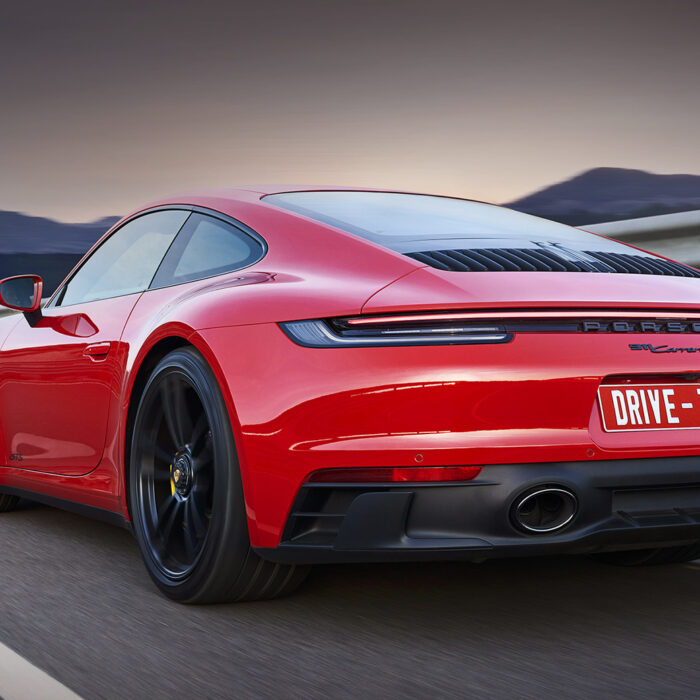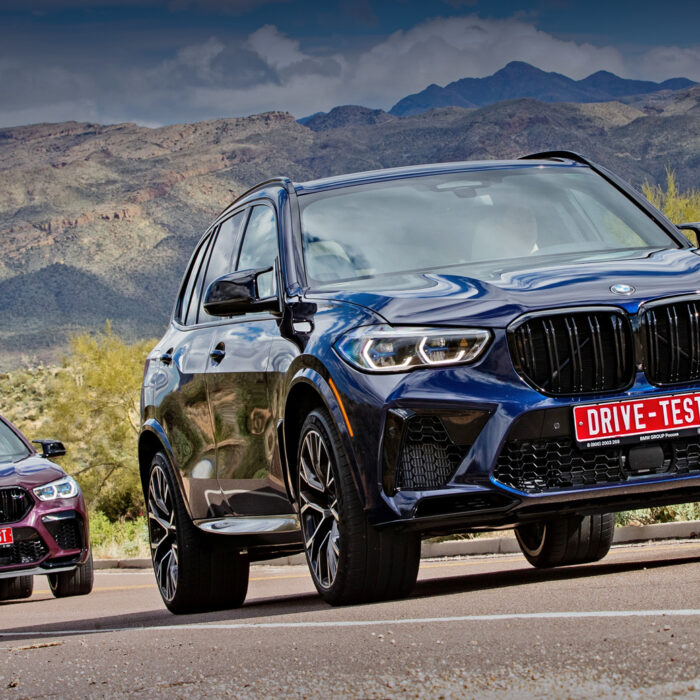本文被设想为典型的实用课程,内容类似于:“您想了解全轮驱动的所有知识,但不知道该问谁”。差速驱动与借助粘性耦合器或 Haldex 型装置连接的驱动有何不同,自锁差速器的用途是什么……但我们对这个问题的历史方面研究得越多,就越感到惊讶。原来,第一辆配备全时四轮驱动的乘用车是在一百年前在荷兰制造的!例如,1935 年,一辆全轮驱动的美国赛车几乎拯救了人类免于第二次世界大战。
乘用车为什么需要全轮驱动?现在,在 21 世纪,这个问题似乎是反问。当然,为了最好地实现发动机的牵引力。为了让车轮在湿滑路面上加速时尽可能少地空转。四个驱动轮比两个驱动轮好!但人类早就理解了这个基本事实。询问任何一位汽车专家,他都会告诉你,大众乘用车的全轮驱动时代始于 1980 年,当时奥迪 Quattro 出现。他还会说出一些罕见的前辈——例如 1966 年的英国超级跑车 Jensen FF 和 1972 年的斯巴鲁 Leone 4WD。然而,真正的专家会立即提出保留意见:第一批四轮驱动的斯巴鲁汽车并没有永久性的全轮驱动——而是分时驱动。正如他们所说,这是苹果和橘子。
权宜之计
对其中一个车轮对采用分时驱动是乘用车的一种权宜之计。分时四驱这个名字来自于 SUV 和越野卡车领域。这种汽车的一个车轴始终处于领先地位,而另一个车轴则在必要时刚性连接,它只有在越野时才能显示其全轮驱动特性。在硬路面上行驶时必须关闭全轮驱动。为什么?原因就是所谓的动力循环。毕竟,在转弯时,前轮覆盖的距离更长,沿着半径更大的弧线移动,这意味着它们比后轮旋转得更快。而在采用这种驱动类型的汽车上,前轮的牵引力会衰减,而后轮的牵引力则相反,会增加。在某些情况下,牵引扭矩可以被制动扭矩取代,也就是说,前轮会增加汽车的运动阻力。车轮下有泥土或积雪也没关系——除非汽车转向更困难,车轮向外转动,像“犁”一样向外移动。转弯时,所有车轮都会沿着其轨迹滚动,并被迫以不同的角速度旋转。因此,全时四轮驱动需要三个差速器:两个轮间差速器和一个轴间差速器。
尽管如此,客运公路车还是使用了封闭式全轮驱动。然而,它们更像是越野车。例如,早在 1938 年,苏联就开始小批量生产 GAZ-61,这是一种四轮驱动的“Emka”,配备六缸发动机和兼职前轴。战后,还生产了“胜利”的“越野”版,GAZ-M72,以及配备类似变速箱的 Moskvitch-410……顺便说一句,1972 年的 Subaru Leone 4WD 也是为了克服越野而制造的 – 配备分时后轴的汽车的离地间隙高于传统的前轮驱动 Subaru。
Subaru Leone 4WD 旅行车(1972-1979)是前轮驱动汽车的四轮驱动版本,配备手动连接的后轮驱动。发动机排量为 1.4 升(72 马力)或 1.6 升(80 马力)。除了旅行车外,轿车和皮卡车也配备了全轮驱动。直到 1989 年,后轮驱动都是手动连接(在手动变速器汽车上),或自动连接——在所有四轮驱动的斯巴鲁汽车上都使用多片式摩擦离合器(在自动变速器汽车上)。
因此,在汽车大部分时间都行驶的铺装道路上,分时驱动毫无用处——它只会让汽车更重。毕竟,这段时间汽车必须“携带”一个分动箱,其中有一个动力输出到“暂时领先的”第二轴,另一个驱动轴,第二轴的主齿轮……
同时,将分时全轮驱动变成全时 4WD 非常容易。只需在分动箱上添加一个轴间差速器即可。
全时四轮驱动
为什么我们需要轴间差速器?两个前轮和后轮间差速器允许每对车轮以不同的速度依次旋转。而轴间差速器则为两个驱动轴完成这项工作。因此,配备三个差速器的汽车可以轻松地在任何道路上以全时四轮驱动行驶!
很简单?同时,直到 80 年代初,人们还认为公路车不需要全时四轮驱动。他们说,为什么发动机要在干燥的沥青路面上不断旋转第二对车轮并将其传动部件与之相连——这既会产生噪音,又会增加油耗……直到奥迪 Quattro 出现后,公众舆论才开始转向全时四轮驱动。毕竟,发动机推力不是一直分布在两个车轮上,而是分布在所有四个车轮上,为横向力的反射留下了更大的抓地力余量。这样的汽车在用发动机加速或制动时在转弯时会更加稳定。
让我们来看看 20 世纪 80 年代后半期的奥迪 80 Quattro 的驾驶体验。Quattro 方案比 Ferguson 变速箱更简单、更紧凑。奥迪自 1984 年以来一直使用 Torsen 自锁差速器。与通过粘性耦合器锁止的差速器不同,Torsen 会对每个车轴的车轮施加的扭矩变化做出反应,增加制动时的稳定性,并允许使用 ABS,因为它仅在牵引力下被锁止。
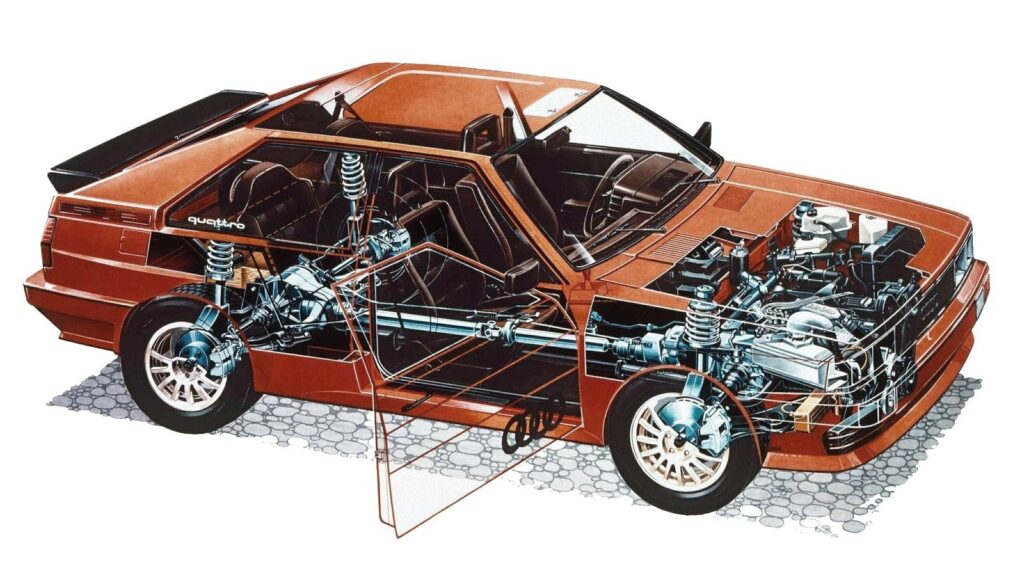
顺便说一句,揽胜(1970 年)和俄罗斯的 Niva(1976 年)被认为是第一批在变速箱中使用轴间差速器的量产汽车。但由于这两款车仍然属于越野车,奥迪 Quattro 收获了乘用车先驱的桂冠。
那么赛车设计师呢——他们之前不是用过全时四轮驱动吗?我们知道,在 Quattro 时代之前,人们就尝试制造四轮驱动赛车。例如,费迪南德·保时捷的战后第一个项目是一款四轮驱动赛车 Cisitalia 360,采用中置发动机布局,配备 12 缸 1.5 升发动机。但可以肯定的是,这款技术奇迹的前轮驱动是兼职的——赛车手只能在赛道的直线路段使用它,在转弯前再次切换到后轮驱动。
Cisitalia 有前身吗?例如,费迪南德·保时捷 (Ferdinand Porsche) 于 1900 年制造了一辆带有四个驱动马达轮的电动汽车。但真正让汽车专家震惊的是荷兰世爵公司 1902 年的一辆赛车。在那个“古老”的时代,当时甚至连刹车都只在后轮上制造,而这辆车实际上是全时四轮驱动——带有轴间差速器!
世爵是一家荷兰马车生产公司,由世爵兄弟 (在佛兰芒语中,这个姓氏拼写为 Spijker) 于 1880 年创立。1900 年,兄弟俩推出了自己设计的第一辆汽车,两年后,在比利时设计师约瑟夫·拉维奥莱特 (Joseph Laviolette) 的帮助下,他们开发了四轮驱动赛车世爵 4WD (1902-1907),其设计令人惊讶地先进——带有三个差速器!还有三种制动机构——两种作用于后轮,另一个制动器安装在前轮的驱动轴上。
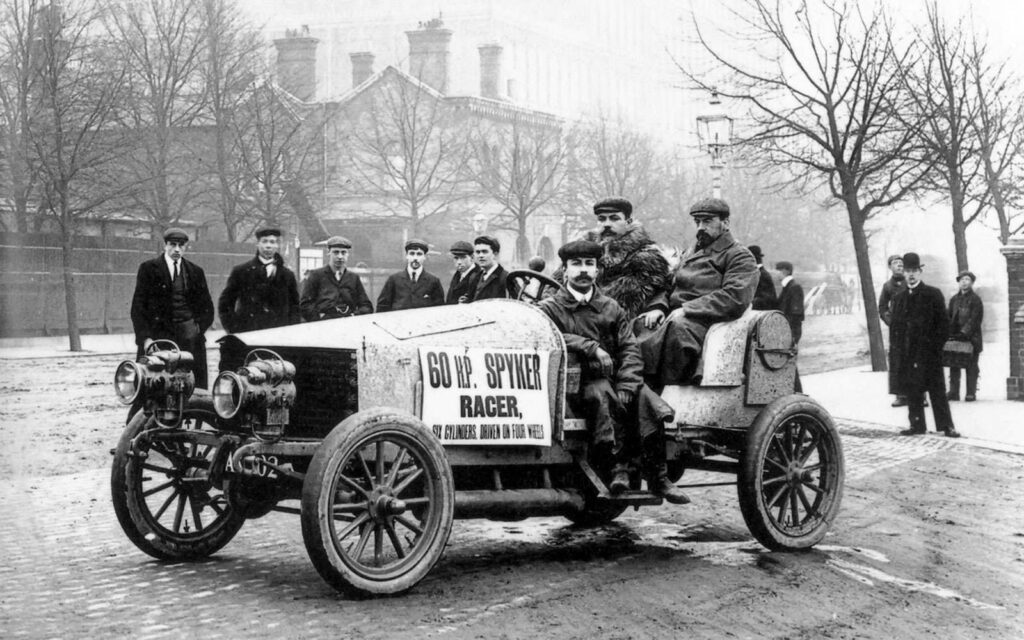
因此,我们可以肯定地说,全时四驱方案已有一百多年的历史了……生产的四轮驱动世爵并不多——它们价格昂贵,而且由于各种原因无法在比赛中取得成功。其他四轮驱动赛车,30 年代早期的布加迪 Tipo 53 和 Miller FWD,也没有取得太大成功。至于布加迪,这项倡议属于菲亚特工程师安东尼奥·皮切托,他于 1930 年向埃托雷·布加迪提议制造一款采用 4×4 车轮配置的赛车。1932 年,三辆全轮驱动的布加迪 Tipo 53 问世——配备强大的 300 马力空气喷射发动机、全时四轮驱动和三个差速器。
带有三个差速器的变速箱将 300 马力空气喷射八缸发动机的推力分配到所有四个车轮上。变速箱与布加迪的惯常做法一样,与发动机分开安装,分动箱与轴间差速器与发动机形成一个单元。前桥和后桥的驱动轴位于汽车左侧,赛车位于右侧。尽管当时的前轮驱动汽车设计师 Albert Gregoire 建议,布加迪 T53 的前轮驱动装置没有使用 Tracta 型等角速度万向节,而是使用了普通万向节。此外,他们还必须在 Tipo 53 中使用布加迪非典型的横向弹簧独立前悬架。所有这些都导致方向盘负荷增加 – 转弯时驾驶汽车极其困难,尽管通过碎石弯的速度高于当时的后轮驱动汽车。布加迪 T53 总共生产了三辆,在 1935 年之前参加了不同的比赛。
有趣的是,意大利人在制造全轮驱动的布加迪之前,仔细研究了米勒专门为拆卸而购买的前轮驱动美国赛车。反过来,美国人哈里·米勒对布加迪的想法产生了兴趣,并决定制造他的汽车的全轮驱动版本,获得了 FWD(四轮驱动)公司的赞助,该公司生产具有 4×4 轮配置的卡车。这就是米勒 FWD 四轮驱动赛车的出现。
美国设计师哈里·米勒在 20-30 年代因其在印第安纳波利斯赛车场参加 500 英里比赛的赛车而闻名,他的直列八缸发动机和两个顶置凸轮轴是埃托雷·布加迪发动机的基础。有趣的是,米勒制造的汽车既有前轮驱动的,也有后轮驱动的。1932 年,他制造了几辆四轮驱动的 Miller FWD 底盘,变速箱中有三个差速器。其中一辆四轮驱动的 Miller 汽车在 1934 年的 Indy 500 比赛中领先,但由于技术故障,最终名列第九。
这些汽车中有一个奇怪的情节:1935 年在柏林 Avus 赛道的比赛中,四轮驱动的 Miller 汽车位列第三,它的直列八缸发动机无法承受,直接爆炸了。与此同时,发动机的碎片几乎落到了看台上,希特勒本人就坐在看台上,和纳粹党的其他重要人物一起!确实,这是一个罕见的案例,没有人员伤亡是值得遗憾的。如果活塞碎片击中了某人的头部,世界历史的进程就会完全不同……
但布加迪 T53 和 Miller FWD 没有得到适当的评估——“原始”设计和不断的故障失败了。但全时四轮驱动乘用车历史上的下一个篇章却真正决定了命运。
弗格森公式
让我们回到理论,以评估 50-60 年代之交英国发生的事情的重要性。轴间差速器旨在“解开”两个驱动轴。例如,后轮疯狂打滑,前轮静止不动。差速器根本无法阻止这种情况!
SUV 设计师首先发明了这种疾病的治疗方法——这是一种正向锁定。驾驶员在正确的时刻拉动控制杆,该机构会紧紧固定轴间差速器的齿轮——变速器从“自由”差速器转变为刚性闭合。第一代揽胜、俄罗斯 Niva 和许多其他 SUV 就是根据这种方案制造的。顺便说一句,还有第一款奥迪 Quattro——直到 1984 年,驾驶员都必须自己打开这些汽车的轴间差速器的锁定装置。
同样,这种解决方案只是权宜之计:公路车上的制动功能只能在越野时激活。您应该在柏油路上关闭它。如果汽车突然驶上湿滑的路段,在施加牵引力时,一个轴的车轮将先于其他轴开始打滑。
是否有可能在打滑时自动使差速器自行制动?自制动轴间差速器的推出与英国人托尼·罗尔特 (Tony Rolt) 的名字有关,他是一名赛车手和设计师。他和他的朋友弗雷德·迪克森 (Fred Dixon) 也是一名赛车手,并且是摆弄汽车硬件的真正爱好者,甚至在战争之前就开设了自己的 Rolt/Dixon Developments 局,用于准备赛车。战后,两个朋友对全时四轮驱动的想法产生了兴趣。1950 年,罗尔特和迪克森制造了一辆名为“螃蟹”的实验性四轮驱动“手推车”,并得到了成功的拖拉机制造商哈里·弗格森 (Harry Ferguson) 的支持。因此,哈里·弗格森研究公司诞生了。
弗格森对赛车不感兴趣,但他梦想着一辆安全的公路车,它的车轮在加速时不会打滑,在刹车时不会卡住。罗尔特和迪克森决定从头开始设计这样一辆汽车——包括车身、变速箱和动力装置!
这对朋友没有足够的知识,克劳德·希尔被邀请担任一位称职的首席设计师,他离开了阿斯顿·马丁,从事如此有趣的工作。但尽管弗格森资金充裕,工作进展缓慢——实验性的弗格森 R4 轿车在六年后才准备就绪。但这辆车真是太棒了:全轮驱动,四缸水平对置发动机,所有车轮均采用盘式制动器,并采用了从航空业借鉴而来的邓禄普 MaxaRet 机电防抱死制动系统!
弗格森 R4(1956 年)是一款采用弗格森公式变速箱的实验性汽车。原型车有一个变矩器而不是变速箱。
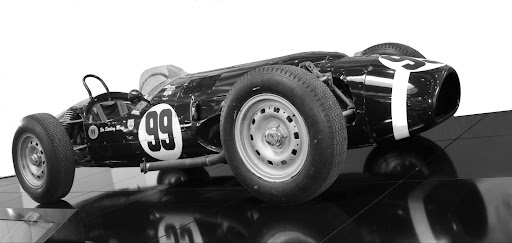
但对我们来说最有趣的是原型车的分动箱内部。拆开后,除了差速器外,我们还会看到一组额外的齿轮、两个球式超越离合器和两组摩擦联轴器。只要车轮不打滑,整个车就会安静地空转。但当其中一个车轴的车轮开始打滑,输出轴的转速差达到一定值时,其中一个离合器就会触发,挤压“它的”摩擦联轴器组——它们会制动差速齿轮,立即将其阻挡,使差速驱动装置变成坚固的驱动装置!
下一个原型车是 1962 年的 Ferguson R5,同样花了六年时间准备,结果更有趣——这是一款四轮驱动的旅行车。后来测试了 Ferguson R5 的 Autocar 杂志的专家分享了他们的印象:“这辆车在极高的速度下达到了滑动的极限!”
1962 年,Ferguson R5 开始量产。
但是,没有一家汽车制造商开始生产世界上第一款配备轴间自锁差速器和 ABS 的全轮驱动旅行车——量产的 Ferguson 会变得过于复杂和昂贵。然而,1962 年,Rolt 仍然成功引起了 Jensen 公司管理层的兴趣——他提议为当时正准备量产的 Jensen CV8 轿跑车改装全轮驱动变速箱,该车搭载 300 马力的克莱斯勒 V8 发动机。事实证明,全轮驱动对于这款强劲高速的轿跑车非常有用!
三年后,实验性的四轮驱动 Jensen CV8 FF 诞生。1966 年,下一代车型——Jensen Interceptor 问世,搭载更强大的 325 马力八缸发动机。除了后轮驱动轿跑车外,还提供了一款带有低调 JFF 铭牌的车型。这就是著名的 Jensen FF — 世界上第一款配备自锁式轴间差速器和 ABS 的全轮驱动量产车!FF 字母代表 Formula Ferguson,这是 Rolt 及其同事申请专利的变速器的名称。
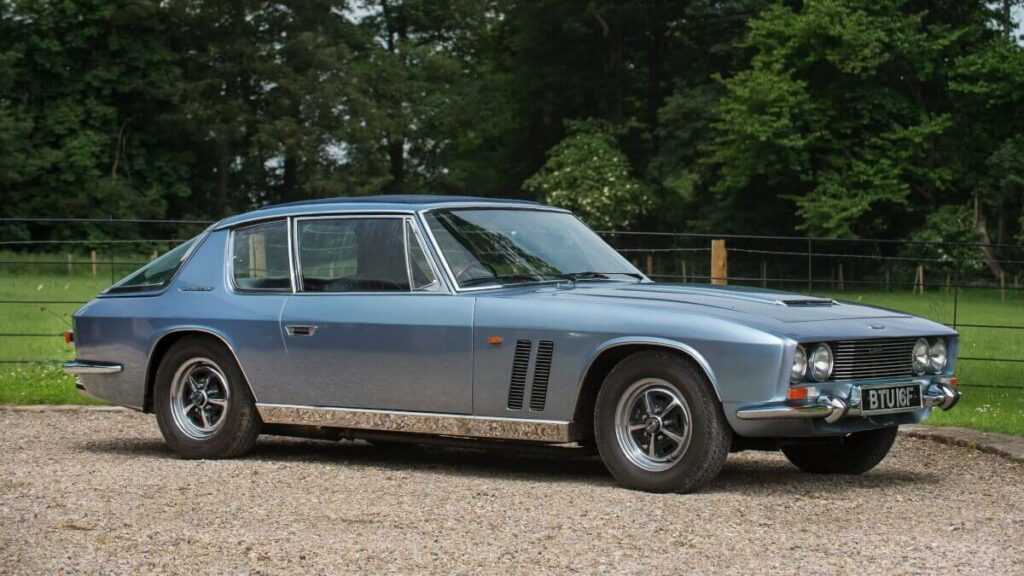
当时的每一位汽车记者都提到了四轮驱动的 Jensens 的出色稳定性和“在湿沥青路面上几乎无限的推力裕度”。可惜的是,弗格森本人那时已经不在人世了——他于 1960 年去世……
我们为什么要如此多地谈论弗格森公式?因为正是 Harry Ferguson Research 在世界上第一次如此认真地关注全轮驱动作为提高主动安全性的手段!
我们已经说过,四轮驱动为横向力的反射留下了更大的抓地力裕度。这是一个优点。但也有一个缺点——失去了对燃油供应反应的明确性。如果你在湿滑的转弯处猛踩一辆强大的后轮驱动汽车的油门,这会导致后轴打滑。相反,在前轮驱动汽车上,当施加牵引力时,前轮会打滑。这是好是坏并不是重点。最重要的是,驾驶员总是知道汽车在这种情况下会如何表现。
四轮驱动汽车的哪个轴会打滑?这个问题不容易回答。如果前车身当前没有负载,或者前轮下方的路面更滑,就会开始漂移。如果后轮的抓地力条件最差,那么汽车就会打滑。反应可能不明确!而且不安全。
Jensen FF(1966-1971)是 Jensen Interceptor 轿跑车的四轮驱动版本。第一款配备自锁式轴间差速器的量产全轮驱动汽车。克莱斯勒 V8 发动机具有 6.3 升的大缸体,可产生 325 马力,并通过三速 TorqueFlite 自动变速箱或 4 速手动变速箱驱动所有车轮。使用 6.70–15 斜交轮胎(类似伏尔加 GAZ-21),整备质量为 1800 公斤的 Jensen FF 时速可达 212 公里/小时,百公里加速仅需 7.7 秒。其他技术特点:带动力转向的齿条齿轮式转向器、所有车轮的盘式制动器、单通道 ABS Dunlop MaxaRet(最大减速)、双叉臂独立前悬架和后部带 Panhard 杆的独立弹簧。1968 年,在英国,Jensen FF 的售价为 6,000 英镑 – 大约相当于最便宜的劳斯莱斯。共生产了 318 辆四轮驱动汽车。
幸运的是,Tony Rolt 本人也是一名赛车手,而且非常出色 – 50 年代初,他甚至赢得了勒芒 24 小时耐力赛。因此,罗尔特和他的同事从一开始就试图通过使用非均衡轴间差速器来避免全轮驱动的歧义。所有配备 Ferguson 变速器的汽车的后轮均受到 63% 的扭矩,前轮则受到 37% 的扭矩。因此,对牵引力增加的反应接近后轮驱动。
自锁式差速器使 Jensen 能够从两种变速器中汲取最佳性能。轻松进入转弯,在正常驾驶模式下不会出现打滑,这得益于差速驱动。而打滑时发动机推力的最佳实现则来自实心差速驱动。
但锁止机构的超越离合器以脉冲模式刚性工作,瞬间将非对称差速驱动转变为锁止驱动,反之亦然。因此,打滑时歧义性增加!需要一种能够更灵活、更平稳地改变轴间差速器锁止程度的机构。 60 年代末,托尼·罗尔特 (Tony Rolt) 和后来成为 Tyrrell 赛车首席设计师的德里克·加德纳 (Derek Gardner) 进行了一项乍看之下很奇怪的实验,实验对象是散热器风扇驱动联轴器中使用的硅树脂液体。没错,罗尔特和加德纳作为粘弹性耦合器的发明者载入史册!
自锁差速器正在发展
一个装有摩擦联轴器组的圆筒,里面装满了硅油,完全符合罗尔特的预期目的——当车轮打滑时,制动轴间差速器的齿轮。虽然所有车轮的转速大致相等,但 viskodrive 不会以任何方式干扰轴间差速器的运行。但现在其中一个轴的车轮打滑了。轴间差速器的齿轮立即开始旋转,与之相连的摩擦联轴器组的粘性耦合器“搅动”硅油,离合器“卡住”,部分或完全阻断轴间差速器。
这种装置可以更平稳、更温和地阻断差速器,这对操纵性有积极的影响。在获得粘性耦合器的专利后,托尼·罗尔特于 1971 年成立了 FF Developments 公司——专门为汽车配备他自己设计的四轮驱动变速器。比如,为英国林业部门生产的四轮驱动版 Bedford 厢式货车、为警察部门生产的一批 Ford Zephyr FF 车、为英国驻柏林军事使团生产的 Opel Senator 4×4 轿车,都是该公司的首批订单。但为 1979 年至 1988 年间生产的美国汽车 AMC Eagle 生产的变速器,才是 FFD 最重要的成就。它是普通的 AMC Concord 乘用车,但车身加高了 75 毫米,并加大了“越野”轮胎。当然,还配备了全轮驱动变速器。此外,这款量产车还首次在世界上配备了由粘滞耦合器阻断的轴间差速器!
当然,AMC Eagle 主要是为了那些定期进行越野冲刺的人而设计的——这些车配备全轮驱动,并不是因为想要实现更稳健的加速或更好的稳定性和操控性,就像 Jensen FF 超级跑车或奥迪 Quattro 那样。但从传动系统来看,斯巴鲁翼豹Turbo、三菱Lancer Evo等驾驶型汽车从第一代到第六代,都成为了AMC Eagle的直接继承者,它们的轴间差速器也由内置粘滞耦合器阻断。
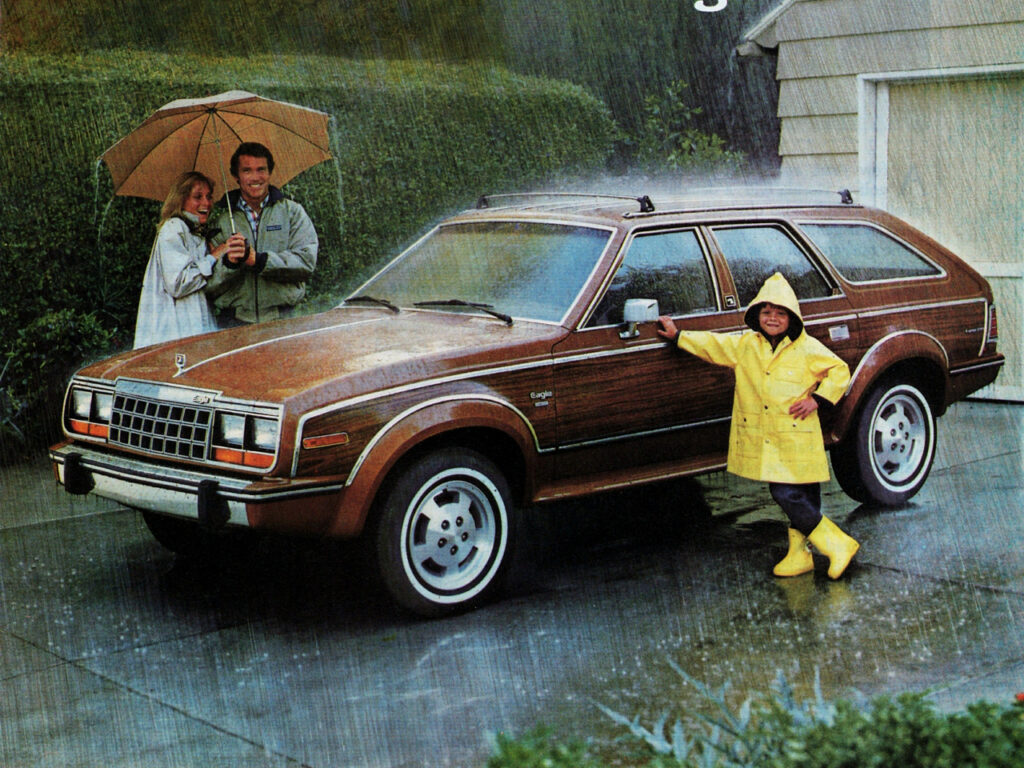
AMC Eagle 分动箱的粘性耦合器是一个圆柱形的壳体,内有摩擦片,内有粘性有机硅液体(硅氧烷),内置于轴间差速器中。当其中一个轴的车轮打滑时,粘性耦合器中的主动和从动盘组会相对旋转,内部压力和温度会升高,硅氧烷的粘度会发生变化——粘性耦合器会制动其中一个输出齿轮,使其无法相对于车身旋转,并阻塞轴间差速器。
量产轿跑车 Audi Quattro 于 1981 年问世,即 AMC Eagle 首次亮相两年后,配备了传统的开放式轴间差速器和正向锁定装置。然而,80 年代初担任奥迪工程部门负责人的费迪南德·皮耶希 (Ferdinand Piech) 为 Quattro 选择了一个非常优雅的方案,该方案非常适合因戈尔施塔特汽车的布局。前轮驱动汽车的纵向动力装置直接通过变速箱端面指向后轮——只需将一个轴间差速器集成到变速箱中即可。但皮耶希的设计师并没有为前轮驱动设计一个单独的分动箱,而是设计了传统的全轮驱动汽车方案。德国人将变速箱的副轴做成了空心的——前轮的驱动轴就穿过了副轴。真是天才的简洁……
从一开始,工程师们就为奥迪选择了与 FFD 不同的沿轴线对称的扭矩分配 — — 50:50。1984 年,老式的“中心”正向锁定手柄终于从全轮驱动的奥迪车舱中消失 — — 我们熟悉的自锁式 Torsen 差速器出现在 Quattro 变速箱中。Torsen 这个名字来自于“扭矩感应”这个词,反映了这种纯机械装置的能力,即根据输出轴上的扭矩变化,即时平稳地增加其锁止程度。因此,Torsen 不需要粘滞耦合器 — — 它会自行锁止。此外,它不是由打滑开始后的转速差异触发的,而是在打滑开始之前触发的:Torsen 能够对轮胎接触面的抓地力条件的变化做出反应!
顺便说一句,当大型 SUV 设计师最近开始考虑实现“乘用车”操控性时,他们也想起了 Torsen——它用于诸如路虎揽胜、大众途锐/保时捷卡宴和丰田陆地巡洋舰普拉多等汽车的变速箱中。
但让我们回到 80 年代。奥迪 Quattro 在拉力赛舞台上的胜利进入是全轮驱动热潮的开始——B 组的所有拉力车队都争相打造 4×4 版本。标致 205 T16、Metro 6R4、兰旗亚 Delta S4、福特 RS200 相继出现。所有这些都是一体式的——采用由 FFD 开发的自锁差速器中的粘滞耦合器。 Tony 的儿子 Stuart Rolt 负责与 FFD 的拉力赛车队合作……
20 世纪 90 年代初,AZLK 工厂也向 FFD 求助,当时他们决定设计 Moskvitch-2141 的拉力全轮驱动改装版。在英国人的帮助下,他们制造出了一种带有三个自锁差速器的变速器,前轮、后轮和轴间(与福特 RS200 赛车上的完全一样)。实验性四轮驱动 Moskvitch 在极端模式下的可操纵性值得最令人满意的评价——汽车在滑行时的行为是可预测的,对赛车手来说很方便。事实证明,通过选择所有三个差速器中阻塞粘性耦合器的“刚度”,可以在很大范围内调整汽车的操控性。例如,更“严格”地阻塞后轮间差速器会增加汽车后轴打滑的趋势。相反,前差速器或轴间差速器的阻断系数增加,稳定性裕度增加——由于前轮打滑和转向不足,汽车不太愿意转弯。
然而,这种调整只与一种情况有关——拉力赛的滑行驾驶方式。因此,三个自阻断差速器是 WRC 集团拉力赛车的专利。此外,通常情况下,这些汽车的差速器中没有内置粘滞耦合器,而是内置了液压驱动和电子控制的多片离合器组。通过这种方式,设计师可以获得最大机会实时配置转向性。例如,车载计算机可以在进入转弯时“溶解”所有三个差速器中的离合器,将它们变成打开的离合器——这样汽车就可以更容易地转弯。当驾驶员开始加速进入直线时,电子设备会发出指令,伺服驱动器会“夹紧”差速器中的离合器,以使所有车轮的滑动最小,同时不会越过可接受的转向不足线,超过该线汽车就会偏离转弯。
顺便说一句,第一个受控离合器是在戴姆勒-奔驰使用的——1986 年奔驰 E-Class 4Matic 的变速箱上,车身为 W124。此外,还有三个离合器——如果需要,电子设备首先将驱动器连接到前轮,然后依次激活轴间和后轮差速器的阻断。但这样的传动装置变得过于复杂。此外,电子设备在不稳定的路面上交替连接和断开前轮……
保时捷公司是高速汽车中使用电子控制离合器的另一个先驱——1986 年的保时捷 959 上有两个离合器,电子设备有四种工作模式供驾驶员选择。后来,日本人开始生产具有类似复杂变速器的量产汽车——例如三菱 Lancer Evo,这是俄罗斯流行杂志 Autoreview 测试过的所有最先进的全轮驱动公路车。轴间控制 ACD(主动中央差速器)和后 AYC(主动偏航控制)差速器与主动扭矩分配的演变能够创造奇迹……
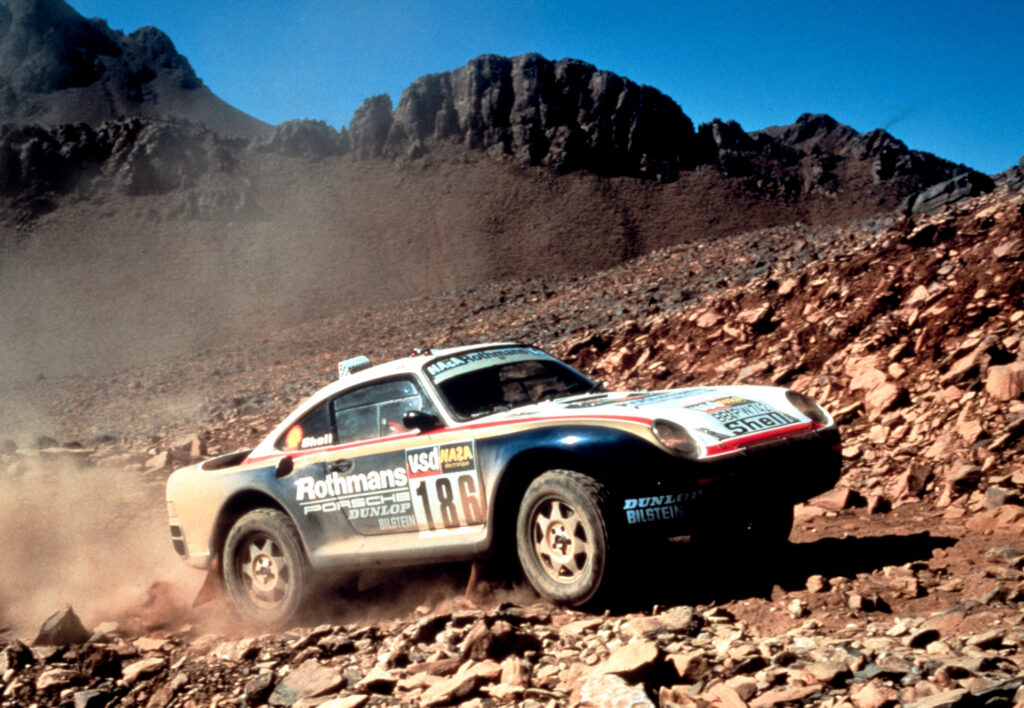
而不是差速器
拉力赛工程师们专注于自锁机制,而大众乘用车设计师则相反,他们选择了简化路线——他们完全放弃了轴间差速器,用粘性耦合器取而代之。1985 年的大众高尔夫 II Syncro 成为第一款配备这种变速器的欧洲乘用车——它的变速器是由 GKN 的工程师开发的,该公司于 1969 年收购了 FFD。这种方案的优点是简单以及全轮驱动模型与基本模型的统一。在正常条件下,汽车保留了前轮驱动汽车的特性和可控性,当前轮打滑时,粘性耦合器在 0.2 秒后触发,能够将高达 70% 的扭矩分配给后轮。
让我们关注一下大众高尔夫 III Syncro 的变速器。分动箱与变速箱相连,粘性耦合器与后轴的主变速器一起安装在缸体中,在前轮打滑时将驱动装置连接到后轮。在大众高尔夫 IV 上,Haldex 耦合器取代了粘性耦合器。
但这种“简化”的后轮驱动有一个明显的缺点——粘性耦合器操作的轻微延迟也会加剧反应的模糊性。在湿滑的转弯处加油时,汽车首先会像前轮驱动汽车一样向外漂移,然后,随着后轮的连接,它的驾驶行为发生了巨大变化——并且可能会打滑。
日本人在这方面表现突出——他们反复尝试消除这一缺陷,选择粘性耦合器的特性,不仅利用它们来启动后轮驱动,还利用它们来阻断轮间差速器。有些车型(例如 1988 年的 Nissan Sunny/Pulsar)有多达三个粘性耦合器:一个用于后轮驱动,另外两个用于阻断轮间差速器。在 Mazda Concerto 4WD 中,粘性耦合器不仅取代了轴间差速器,还取代了后轮轮间差速器……
但后来发现,在后轮驱动中,使用由液压驱动压缩的摩擦离合器组比使用粘性耦合器要方便得多。电子设备可以完美控制摩擦离合器的压缩,从而调整施加到后轮的扭矩值。
如今,大多数四轮驱动乘用车和 SUV 都在其中一个轴的驱动装置中配备了受控离合器——无论是大众高尔夫平台汽车上的 Haldex、本田的 VTM-4 系统还是宝马的 xDrive。此外,现代离合器的快速运行速度使得连接车轮的延迟几乎不可察觉——现在一切都只取决于控制电子设备的配置方式。例如,高尔夫 4Motion 和奥迪 A3 Quattro 的变速箱在设计上完全相同。但不同的软件允许大众设计师选择轴之间的对称扭矩分配,而奥迪工程师更喜欢将 40% 的推力仅分配给后部,从而使他们的汽车具有更多的前轮驱动特性。这只是个人品味问题……
而驾驶员更喜欢哪种方案呢?现在,手动连接到第二轴的驱动装置的公路乘用车已经停产,谢天谢地。至于其他三种方案……
当然,从我们的角度来看,最有趣的汽车是弗格森公式的继承者,其变速箱中有一个自锁式轴间差速器。而锁止方式并不重要——通过粘性耦合器(如斯巴鲁)、通过 Torsen 机械差速器(如奥迪 A4-A6-A8 Quattro、大众辉腾)或通过电子控制离合器(三菱 Lancer Evo)。最重要的是,经过适当配置的自动锁止“中心”可以显著改善汽车的操控性——让经验丰富的驾驶员更安全、更愉快。
当今的主要趋势是可变推力矢量,当电子设备命令扭矩预先施加到车轮上时,车轮能够尽可能高效地实现扭矩。目前,三菱 Lancer Evo X 轿车拥有世界上最复杂的全轮驱动变速箱。附加齿轮组能够在后轮之间传递扭矩,中心由电子控制离合器阻挡,前部有一个传统的机械自阻挡装置。我们所知道的全轮驱动时代将随着带有四个电动轮的电动汽车的出现而结束。
但我们也不会低估配备分时后轮驱动的汽车——它们的数量越来越多。Haldex 联轴器最近被沃尔沃和萨博积极使用。带有开放式轴间差速器的变速箱也得到了应用——在所有级别的梅赛德斯 4Matic 等高速汽车上。但在这些汽车上,除了差速全轮驱动外,全时防滑电子设备也必须运行,这在一定程度上弥补了自阻挡机制的不足。
Haldex 多片离合器由轴转速的轻微不匹配触发。任何一个凸轮面的旋转都会导致滚轮开始在工作表面上滚动并来回移动,从而推动泵环形缸中的活塞。活塞通过压缩盘组的活塞将油泵入从动缸。但电子设备可以在电磁阀的帮助下释放压力,从而灵活地调整提供给车轮的扭矩值。
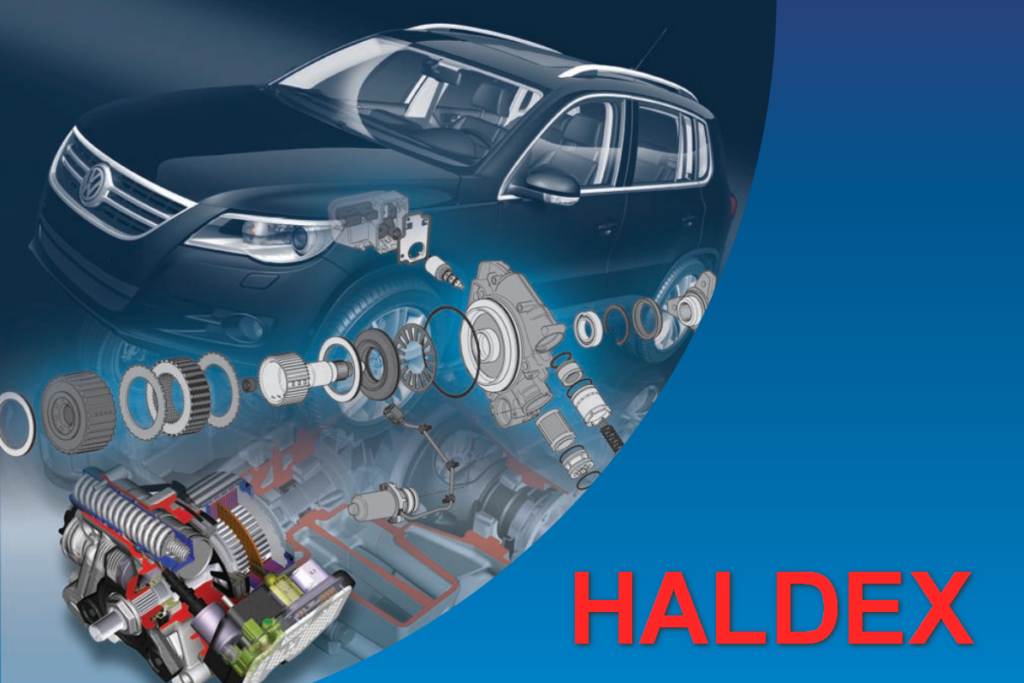
然而,我们最近注意到,配备不同四轮驱动变速器的汽车的实际驾驶特性越来越接近——当然是在公共道路上行驶时,而不是在拉力赛道上。而且 Haldex 类型的电子防滑系统和离合器控制程序越先进,配备它们的汽车的转向性能差异就越小。显然,这是进步。
這是翻譯。您可以在這裡閱讀原文: https://www.drive.ru/technic/4efb336400f11713001e4f54.html

出版 十一月 04, 2021 • 9m

